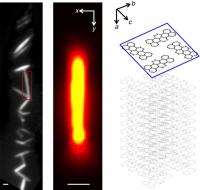
An article by J. A. Labastide, H. B. Thompson, S. R. Marques, N. S. Colella, A. L. Briseno & M. D. Barnes is featured in a recent issue of Nature Communications.
The Barnes and Briseno groups analyzed single crystals of 7-8-15-16, tetraazaterrylene (TAT), an n-type semiconductor of the rylene family of dyes. Using time- and polarization-resolved photoluminescence spectroscopy, they discovered that they could induce directional charge separation within the isolated single crystals via manipulation of the excitation polarization.
Both dipole–dipole (Frenkel exciton) and charge-transfer coupling occur almost exclusively along the crystal axis, and by optically exciting with this direction of polarization, short-lived inter-chromophore excitations decompose into charge-separated polaron pairs. This charge separation was characterized by the power-law decay in the photoluminescence. Furthermore, the amplitude and decay exponent were dependent on the aspect ratio of the crystal. In contrast, exciting orthogonally, across the crystal axis lead to an exponential decay characteristic of Frenkel excitons localized on individual molecular sites.
This study demonstrates the potential for both enhancement and directional control of photogenerated charge-separation efficiencies in small-molecule semiconductor assemblies without the need for an interface.




